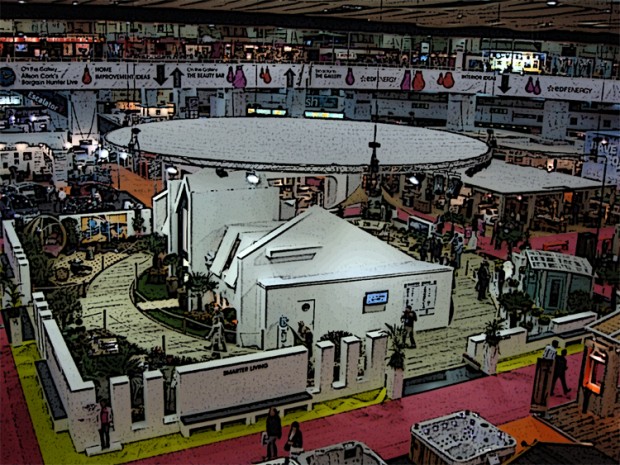You have no items in your cart. Want to get some nice things?
Go shopping
The Daily Mail started the Ideal Home Show in 1908 to showcase and sell popular designers’ visions of the future. Over the subsequent 106 years, pausing only for the Second World War, it has grown into something of a leviathan. For three weeks every year, a huge circus rolls into town and throws up over 600 exhibitions overnight so that a sprawl of visitors can swarm upon displays of domestic design and overpriced ornamentation in a sort of docile frenzy and so that we can find out what has happened to all of those minor celebrities who used to be on Ground Force or Changing Rooms and still have mortgages to pay because they spent too much on coke in the Nineties.
This year it was held in Earl’s Court, the entire outside of which was decorated with garish floral wallpaper designs that appeared to have been drawn in crayon. The sight of this was uninviting but, possessing as I did a pair of tickets, I was determined to enter and carry out my research goals: to experience the show as an observer, to find out what it’s about, where it fits into modern ideas of consumption and domesticity and what, if anything, it reflects about our society’s model for the “ideal” home.
The place was huge, with mocked-up rooms, whole gardens and swimming pools sprawling across the entire ground floor, and a ring-shaped upstairs section full of food, drinks and the suspect timesaving doodahs usually reserved for early-morning infomercials.
“With the new Step’n’Steam you can easily go from ironing to changing a lightbulb! Just tuck in this tab, extend the baseplate, unscrew the trammel, fold back the board, click it into place, and – oh, hold on a sec, folks… There! Now you can use it as a ladder!”
There was something disturbing about it that I couldn’t at first place, but after a while I started to get an inkling. The domestic, usually a private space protected by barriers and rituals to control entry, had been made public. This created a feeling of voyeurism that was enhanced by the exhibitors’ attempts to create the illusion of lived-in spaces, placing lofty tomes on bookshelves, fruits in bowls and even – to my pleasant surprise – stocking fridges with cans of beer, pre-mixed gin and tonic and champagne. These efforts drew me into the fake kitchens, bedrooms and lounges to snoop about furtively, pick up books, look in drawers and generally behave as if I’d been left in a stranger’s house while they had popped out to the shops.
After wandering around for a while, getting an impression of the place and sipping on cans of gin and tonic from a Smeg fridge, I realised that I hadn’t been paying sufficient attention to my fellow punters. Who were they? As they walked around among the imitation living rooms, kitchens and bedrooms, they recalled Sartre’s waiter, trying to embody perfectly their roles as homeowners, home-shoppers, saying only what the salespeople manning the ghost homes wanted to hear. [1]
Who were they “really”, outside of this liminal space? The average household income of visitors is apparently £30,000-£60,000, which seemed to match with their attitude and dress: middle class, half established, probably still paying off their mortgages; comfortable enough to be free on a Thursday afternoon, but not enough to be trusted with full bottles of champagne as part of the jacuzzi displays. [2]
The homes of the show represented the lifestyle of a social class with a slightly higher status than the majority of the punters. The items on sale were not just material objects, but units of what Pierre Bourdieu called “cultural capital”. Think of it this way: the sort of person who owns an AGA is the sort of person who occupies a certain social status, and the ability to buy one is a semi-honest display of the wealth required to occupy that status and the possession of the sense of taste associated with its members. Therefore, making the purchase becomes a sort of speech-act that both creates and demonstrates the social class and identity of the buyer. [3]
“Show” is certainly the word. Even the largest of families would be pressed to justify the need for a twelve-hob range and a ten-foot-long sofa. The “ideal” is not one of domesticity and family closeness, but that of an exhibition space where one’s taste and wealth can be displayed to envious observers.
Of course, the meaning of possessions goes beyond social status. As Daniel Miller explores in The Comfort of Things, when asked questions about their identity and values people will often answer with reference to material anchors. His sample of Londoners made sense of their ideas and histories through their possessions, using domestic objects to curate and display aspects of their own identities and world views.
Did this apply to the punters at the Ideal Home Show? Can 72-inch HD TV screens disguised as mirrors act as material anchors to a set of values? Perhaps so. As one of my informants put it:
“Well it’s better than Ikea, isn’t it? Less soulless. A lot of the stuff they’ll actually make specifically to fit your home, so you know you’ll never walk into someone else’s house and see the same thing.”
Many of the vendors emphasised the uniqueness of their products and offers, advertising them as “not available online”, “exclusive to this show”, or “made to measure”. Visitors seemed to value the idea that the objects they bought, although designed by someone else, would somehow be unique to them, expressing their own individual taste.
The identity fusion between the individual and the house that informs England’s particularly strong obsession with home ownership is subverted by mass production. People were looking for a way to reclaim their domestic spaces from the generic, flat-packed products that serve as a constant reminder of the outside world, becoming interstices between the public and private spheres by carrying their own stories with them, stories of mass production and global capitalism and resisting the imposition of personal meanings through the fact that they exist, in spirit, across multiple homes. Objects that are “unique” have a much greater potential to be imprinted with stories and meanings relevant specifically to the individuals and families that own and use them.
The illusion of uniqueness was betrayed, however, by an air of mass consumption, something very American, from the jostling crowds and the shouting pedlars of ill-conceived kitchen contraptions. With all the the hawking and patter, the whirring and the clatter, the place was starting to get to me. I was trapped in the dense jungle of soft furnishings and white goods, overwhelmed by the noise, the people, the shapes. My research assistant and I needed to get out, but we knew that we weren’t quite done yet. After all, there was one essential feature we had yet to milk for our advantage.
Picking up a delicious thimbleful of Châteauneuf-du-Pape from a little plastic shot glass, I was struck by a gaping contradiction: that there were so many free things available at what amounted to a turbocharged, consumerist sales frenzy. To explore this apparent contradiction fully, my research assistant[4] and I decided to see just how much drink we could conceivably squirrel away.
We decided to go for broke as we high-tailed it out of there. We staggered down to the Smeg kitchen display area, furtively glancing around for sales assistants in their tell-tale charcoal suits and badly knotted ties. For the first time that day, one of them was demonstrating in front of the very fridge from which we aimed to pilfer two bottles of champagne that we had noticed earlier. In order to avoid hanging around suspiciously, we popped out through a service exit to the staff smoking area, from which it turned out there was a clear run to the street. Emboldened by the discovery of this new escape route, we re-entered, marched over to the refrigerator and quickly stuffed two bottles of Taittinger into a bag before walking purposefully but unhurriedly out.
Once we got around the corner we started giggling like schoolboys at having pulled off such a brazen heist. However, our joy was short-lived, for as soon as I removed the bottles from the bag I saw that we had been duped. Although they were fully sealed, corked and labelled, the bottles were empty. I sank into a deep squatting position with my head in my hands in the middle of the pavement, but after staying like that for about a minute I suddenly began to howl with laughter. Somehow it all seemed so incredibly appropriate. Like myself pretending to be a customer, the bottles, for all their apparent promise, had turned out to be all show, ultimately empty.
I thought about those empty bottles, wondering whether they symbolised how the rewards of my greed would always end up hollow, and I thought about all the non-existent people who didn’t live inside the show rooms currently filling up Earl’s Court, didn’t drink champagne all day in their hot tubs, didn’t watch television on ten-foot-long suede sofas and didn’t lay on huge dinner parties every night in the endless summer of our collective English imagination. For a short moment I envied them their non-lives. But then I was in Waitrose buying cheap prosecco to replace the lost champagne, and I had forgotten that they even never existed.
[1] The following transcription of an exchange between two of my informants and a salesman demonstrates this pandering attitude:
Sharon: “Yes, well, we were thinking of buying a new kitchen. I mean, the one we’ve got is… Well, it’s fit for purpose, I suppose – wouldn’t you agree darling? … Darling?”
Dave: “It does the job.”
Sharon: “Yes, it does the job, but you do feel – one does feel – spending so much time in there, that you want your surroundings to be liveable… Well, maybe not right now, but we’re expecting a raise and we’re going away next month… Can I take your card?”
And, of course, for most the card remains in some forgotten pocket or wallet and the number is never called.
[2] Perhaps this is unfair. After all, who could be?
[3] Or at least that’s what they hope…
[4] My flatmate, who I had brought along partly to assist in my observations, and partly because I had been given a spare ticket.

About The Anthropologist
The Anthropologist is pseudonym for Declan Clowry, a writer and reviewer who also happens to have two degrees in Anthropology from Oxford University. He has previously completed research projects on the evolution of aesthetic preferences and on how people respond to cartoon characters, as well as participating in fieldwork in South East Asia. He now mainly uses his talents to apply a (not entirely serious) anthropological perspective to some of the more interesting situations in which he finds himself.




